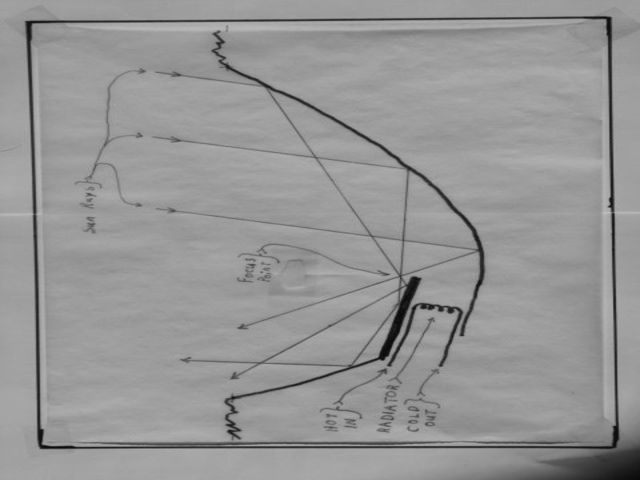Difference between revisions of "User:Farred/test"
(add image of model shelter) |
(addition) |
||
| Line 13: | Line 13: | ||
[[File:Model 4 thermal shelter.jpg]] | [[File:Model 4 thermal shelter.jpg]] | ||
| + | |||
| + | ::Thermal Shelter on the moon | ||
Revision as of 14:17, 1 February 2024
I intend to upload a picture here.
This charming image does not convey the words included in the original work because of insufficient resolution. On the left edge of the image from top down are the words:"HOT IN", "RADIATOR" and "COLD OUT". Arrows from the words point to features in the picture. On the top are the words: "Sun Rays". In the middle of the image are the words focus point. The image is a cross section of a parabolic ditch on Luna running East and weast at the 13 degree North latitude. The projetion of sun rays into the plane of the image is always tilted about 13 degrees to the right of vertical, ranging from 11.5 to 14.5 degrees from vertical. South is to the right. The radiator is always protected from sunlight, from infra red radiation from the surroundings and from micrometeoroids. The image is not intended to be to scale of an actual device, but merely to communicate the concept.
What can be built on the moon soon is a thermal shelter for remote controlled devices. Naturally, if a device sent to do work on the moon fails because it is vulnerable to the overnight low temperature of the two week long lunar night, it will not accomplish much work on the moon. It should be possible for a remotely controlled device to assemble a thermal shelter out of prefabricated pieces during the lunar day so it can be sheltered during the night and work again next day.
The lunar regolith is good insolation on the moon where it exists in a vacuum. At a depth of a foot or more in fine particles there is no great variation in temperature from day to night. A shelter could be covered with a foot of fines for insulation making good thermal protection. A door to the shelter could be made from prefabricated panels with a 14 inch hollow space between them. The space could be filled with sifted regolith fines for great insulation. The door could be carried by a remote controlled device on the moon as it enters the shelter it assembled. The door would be left at the doorway of the shelter to complete the thermal insulation.
Reasonably inexpensive (relative to other space probes) and simple devices could use such a shelter on the moon and survive the night to work again the next day.
- Thermal Shelter on the moon









